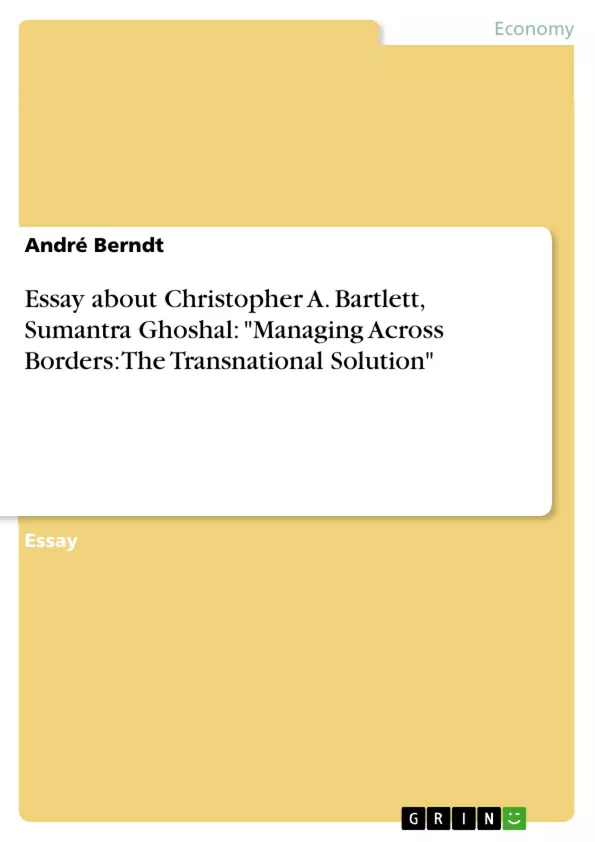The book “Managing Across Borders, The Transnational Solution” by Christopher A. Bartlett and Sumantra Ghoshal is about the challenges of international business particularly in 1980s. The authors divided the book in three main parts.
The first part, called ”The Transnational Challenge”, deals mainly with conceptual issues like the definition of multinational, global and international companies as well as structural fit and administrative heritage. Accordingly this chapter of the book tries to answer the question ”why” nowadays transnational organisations are needed.
The second part, called “Characteristics Of The Transnational”, describes mainly the three key attributes of the transnational organisation. Which are the integrated network configuration of assets and activities, flexibility due to specialised roles and responsibilities and last but not least the facilitation of learning due to multiple innovation processes. Therefore this part of the book considers the question “what” is the transnational organisation. The third part of the book, called ”Building And Managing The Transnational” prescribes mainly what managers have to do in order to build and manage an organisation that corresponds to the model of the transnational organisation. This means that, this chapter tries to answer the question “how” can a transnational organisation be build.
Not to mention there is a fourth part in the studied book, called “Appendix: Research Methology” in with the authors describe their method of research and data collection more detailed than within the first three parts of the book. Succeeding I am going to summarise the content of each part more detailed.
Table of Contents
- Summary of the book
- The Transnational Challenge
- Characteristics Of The Transnational
- Building And Managing The Transnational
- Opinion about the book
- Personal example of the books idea…
Objectives and Key Themes
This book examines the challenges of international business, specifically in the 1980s, and proposes a "transnational" organizational model as a solution to managing a company's worldwide operations in a highly competitive, volatile and changing business environment.
- The need for transnational organisations to adapt to the evolving global competitive landscape.
- The key attributes of a transnational organization, including an integrated network configuration, flexibility, and facilitated learning.
- The importance of understanding a company's administrative heritage and how it can either aid or hinder the transition to a transnational model.
- The challenges of achieving global efficiency, local responsiveness, and worldwide learning simultaneously.
- The importance of developing multidimensional strategic capabilities to meet the complex demands of the global marketplace.
Chapter Summaries
The first part of the book, "The Transnational Challenge," explores the changing nature of international business in the 1980s and introduces the need for transnational organisations. It discusses the inadequacies of traditional organizational models (multinational, global, and international) in the face of new pressures. The authors argue that companies need to develop multidimensional capabilities, including global efficiency, local responsiveness, and worldwide learning, to succeed in the global marketplace.
The second part, "Characteristics Of The Transnational," details the key attributes of a transnational organization, emphasizing an integrated network structure, flexibility through specialized roles, and learning facilitated by multiple innovation processes. This part explores how a transnational organization can leverage its resources and capabilities to achieve the three strategic goals identified in the first part.
The third part, "Building And Managing The Transnational," focuses on practical strategies for building and managing a transnational organization. This section delves into the process of transforming existing structures and administrative systems to achieve the required flexibility and adaptability, considering the impact of a company's administrative heritage.
Keywords
The book "Managing Across Borders" focuses on the challenges and solutions of international business in a rapidly evolving global market. Key terms and concepts include transnational organization, global efficiency, local responsiveness, worldwide learning, integrated network, administrative heritage, and strategic capabilities. The authors utilize case studies from various industries and companies to illustrate their points and provide practical insights for managing international operations.
- Quote paper
- André Berndt (Author), 2003, Essay about Christopher A. Bartlett, Sumantra Ghoshal: "Managing Across Borders: The Transnational Solution", Munich, GRIN Verlag, https://www.grin.com/document/20527



